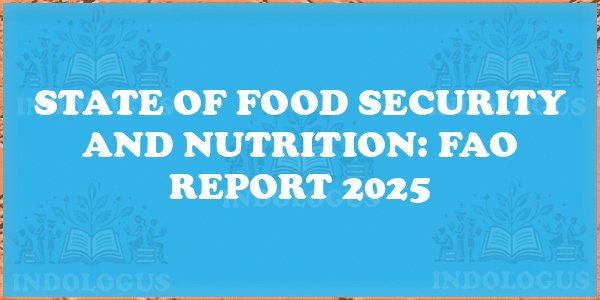The FAO’s State of Food Security and Nutrition 2025 report reveals the impact of high food price inflation on global hunger and malnutrition. Explore the causes, consequences, and solutions for achieving Sustainable Development Goal 2: Zero Hunger by 2030.
Overview of Global Food Security
- Access, affordability, and distribution challenges contribute to hunger and malnutrition.
- United Nations’ SDG 2 aims to end hunger and improve food security by 2030.
- Recent surge in food price inflation poses a threat to achieving Zero Hunger.
Global Food Security: Current Situation
- 8.2% of the global population experienced hunger in 2024.
- Africa remains the most affected continent, with one in five people suffering from hunger.
- 2.3 billion people worldwide face food insecurity, with rural communities and women at higher risk.
The Cost of a Healthy Diet
- The average cost of a healthy diet globally was $4.46 per person per day in 2024.
- 72% of the population in low-income countries cannot afford a healthy diet.
- 2.6 billion people globally lack the income for a nutritious diet.
Malnutrition: Persistent Challenges
- Child stunting has decreased, but child wasting and overweight remain stagnant.
- Adult obesity rates are on the rise, while anaemia in women has worsened.
The Surge in Food Price Inflation
- Food price inflation rose sharply between 2021 and 2023.
- Multiple factors, including the COVID-19 pandemic and war in Ukraine, drove the surge.
- High food prices impact purchasing power and nutrition choices of households.
Impact on Households and Nutrition
- High food prices lead to less nutritious food choices and meal frequency reduction.
- Low-income countries bear the brunt of food price inflation, exacerbating global inequality.
- Increased consumption of ultra-processed foods poses health risks.
Policy Recommendations for Food Security
Short-Term Measures
- Targeted subsidies for essential nutritious foods.
- Tax reductions on healthy food items.
- Cash transfers and social safety nets for balanced diets.
Long-Term Strategies
- Building strategic food reserves for price stabilization.
- Investing in agricultural productivity and technology.
- Strengthening market information systems for quick responses to price changes.
- Promoting diverse food production to reduce dependency on staple crops.
- Regulating and promoting healthy diets while discouraging ultra-processed foods.
Key Takeaways for Competitive Exams:
- Understanding the challenges of food security and nutrition in achieving SDG 2.
- Effects of high food prices on global hunger and malnutrition.
- Policies and strategies to address food price inflation and promote healthier diets.



